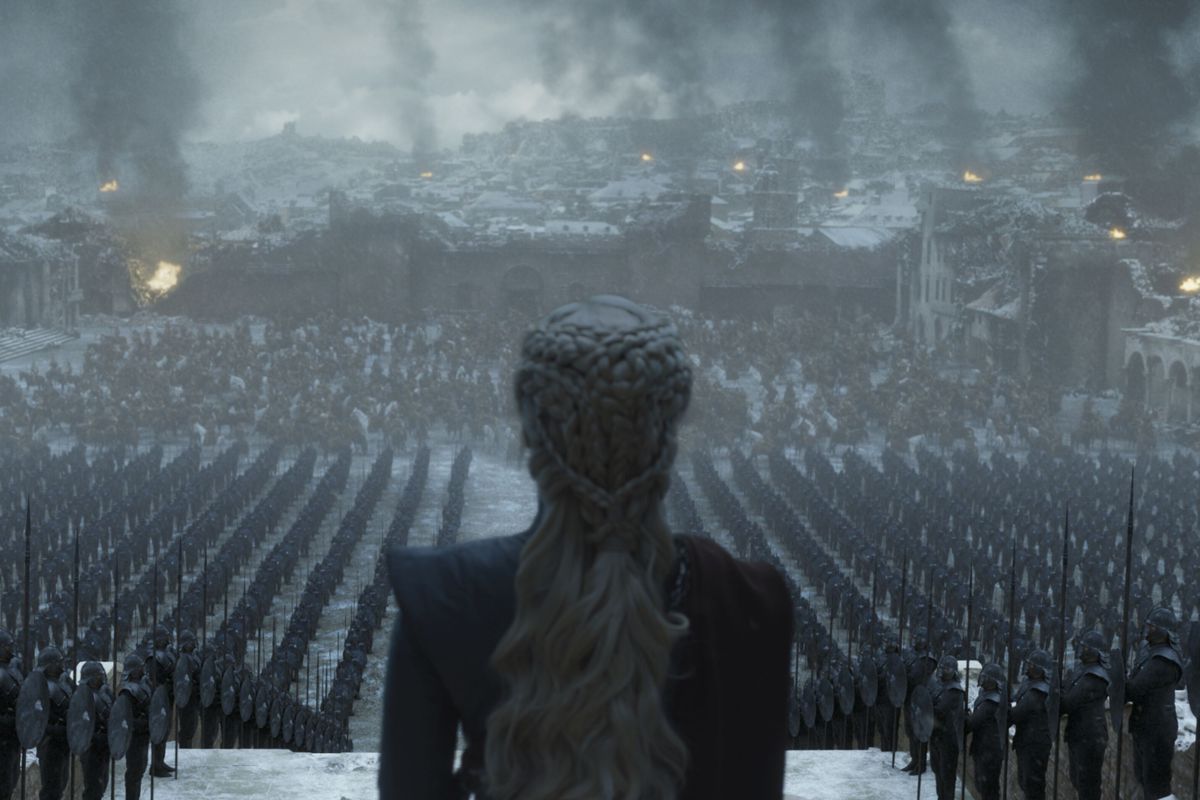Despite its strong start, multi-million dollar budget, and record-breaking 32 Emmy nominations, Game of Thrones’ final season was met with mixed reviews – the lowest among all eight seasons. A lot of the criticism has to do with the condensed story (each season had 10 episodes and originally showed that it took several episodes to travel around Westeros), plot holes, and decisions made by the showrunners.
Still, there are a lot of things that were good about the show: from the acting, production, and costume design. From Daenerys Targaryen’s hair to Sansa Stark’s highly meaningful dress in her final scene, despite the hiccups and that failed to end the masterpiece that is Game of Thrones, the show has made itself an icon and notable figure of pop culture.
Personally, I’d have to agree with the criticism surrounding the final season. And while I don’t want to talk about why I didn’t like the show (you’ll find enough bloggers and anyone with a Twitter handle doing that online), I found that not a lot of people noticed the one thing that irked me: the way they handled Daenerys Targaryen’s hair evolution.
I get that arcs such as Jon Snow’s parentage or Arya’s skills as a faceless assassin take precedence over how Daenerys or Sansa style their hair, but as someone who appreciates the skill of Michele Clapton’s costume skills in adding messages into each stitch of fabric, I found it irritating that the evolution of Sansa’s hairstyles rode out to the very end, while Daenerys’s evolution came to an abrupt end with no resolution.
Sansa vs. Daenerys’ Hair Evolution
There are two fairly popular theories going around about Sansa Stark and Daenerys Targaryen’s hair. Sansa’s hair, on one hand, mirrors the people and culture she’s learning from or immersing herself in. We meet her in season one sporting a hairstyle common in Northerner girls, only for her to start imitating Cersei Lannister. When Margaery Tyrell comes to King’s Landing, she becomes Sansa’s new role model and wears her hair similar to the ladies of Highgarden. During her return to the North and forges her own inner strength, she channels her mother, the late Catelyn Stark, through her hair.

After the Starks take back the North and Sansa rules as Lady of Winterfell, she channels Cersei’s hair once more not because she still idolizes Cersei, but because she has learned enough from Cersei and is now channeling her skills as a player in the Game of Thrones. Finally, on her last scene when she is crowned Queen in the North, she wears her hair down – free of braids and any styling – as a symbol that she isn’t channeling anyone else and is now her own person. It’s a visible and meaningful evolution with a fitting end to the way Sansa handles her hair.
Daenerys’ hair, on the other hand, follows the theory that she practices the styling done by khals of the Dothraki culture where her first husband, Khal Drogo, was from. Throughout the seasons, audiences noticed that Daenerys started the series with her hair down without any braids. But as the series progressed and Daenerys successfully killed her enemies and ended unjust systems she had once been a victim of, her hair sported more elaborate braiding.
Unlike Sansa, however, we never get to see closure of the end of her hairstyle. Sure, it may be because Sansa lives while Daenerys dies, but the inability for the show to put closure on something as simple as Daenerys’ hair evolution is another reason why that unceremonious death of hers wasn’t the best way to go.
So, let’s take a look at Daenerys’ hairstyle and braids. In this article, we dissect everything we need to know about our favorite dragon queen (and all of Daenerys’ other titles) and why, at the end, the death of her character could have been handled a lot better.
Why Is Daenerys Targaryen’s Hair Color Like That?
Daenerys was born a member of House Targaryen, a dynasty of rulers who can trace their ancestry back to the only surviving dragonlords of Old Valyria. When the event called “The Doom of Valyria” led to the collapse and destruction of the city, the Targaryens were one of the few families to escape destruction after one of their family members, Daenys Targaryen, had a dream foreseeing the Doom.

They made their way to Dragonstone in Westeros, where the family would live a hundred years before Aegon Targaryen, known as Aegon the Conqueror, decided to conquer the Seven Kingdoms of Westeros under Targaryen rule. The Targaryens would rule Westeros for almost 300 years until Daenerys’ father, the Mad King Aerys II, was overthrown and replaced by House Baratheon, whose claim to the throne was due to distant blood relation to the Targaryen family.
While most people of Westeros are descended from the First Men (the North), the Rhoyne (Dorne), and the Andals, the Targaryens hail from Essos in the city of Valyria, which was known for its magic. Prior to the Doom, Valyrians had common characteristics that distinguished them from other cities in Essos as well as the rest of the world. Valyrians sported pale skin, purple or light blue eyes, and silver-gold or platinum white hair.
The Targaryens had these Valyrian features, and being dragonlords, they also had higher heat tolerance. Because of their incestuous practice of marrying relatives to keep the bloodline pure and the power within the family, these physical features continued to be a staple with every Targaryen born into the family – but at the expense of madness and other defects that come with inbreeding.

There are cases where Targaryens and their cadet houses with Valyrian ancestry marry non-Valyrian spouses. In this case, either the Valyrian features become dominant (as with Daenerys’ great-grandparents: her great-grandmother was not a Targaryen but their descendants showed Targaryen traits), disappear (as with Jon Snow), and become mixed (as seen in Aegon Rivers, a half-Targaryen mentioned in the books to have purple eyes but regular Andal features).
Daenerys was no exception to the Targaryen traits. In the books, she had violet eyes, pale skin, and silver-gold hair. In the show, however, she and Viserys had violet contact lenses in the Pilot episode, but this was removed by showrunners David Benioff and Dan Weiss. The two said in the Game of Thrones DVD commentaries that the contact lenses affected the way they portrayed emotion. However, they maintained the white hair to establish the Targaryen’s foreign roots.
Dothraki Culture
On the first episode, “Winter Is Coming,” Daenerys’ brother Viserys marries her off to Dothraki leader Khal Drogo in exchange for an army. While Daenerys initially finds Dothraki culture violent and rowdy, she learns how to become a part of the khalasar (tribe) and makes her husband see her as his equal, not his submissive wife.
https://www.youtube.com/watch?v=7gQyk9DmtHg
In Dothraki warrior culture, a man’s combat skills is gauged by the length of their hair which is tied in braids. When they are defeated, they or their opponent cuts off their braid so that the world can see the humiliation of their loss.
When Daenerys and Khal Drogo meet for the first time, Viserys points out Drogo’s hair, which reaches down to his thighs in accordance with the books. Viserys and his ally, Illyrio Mopatis, chooses Drogo due to the fact that he has a large khalasar with fierce warriors and he himself has never been defeated in combat. During their wedding, we see this practice when two guests get into a fight. After the winner delivers the fatal blow, he immediately cuts off the loser’s braid as a sign of his humiliating loss.
In the episode “Cripples, Bastards, and Broken Things,” Daenerys gets into an argument with Viserys when he accuses her of treating him like a subject and trying to dress him like one of her Dothraki. He mocks their practices and asks if she’ll braid his hair, but for the first time in her life, she stands up to him and says he does not deserve a braid because he has never won a battle.
While this practice is limited to Dothraki men, after Drogo dies and Daenerys defies Dothraki culture by refusing to return to the dosh khaleen (a place where khaleesis, wives of dead khals, stay for the rest of their lives) in Vaes Dothrak. Instead of growing old in Vaes Dothrak, she decides to run whatever is left of her husband’s khalasar as its khaleesi. And this is where the symbolism of her braid begins.
Evolution of Daenerys’ Braids
In season one, you see Daenerys’ hair either let down or in small loose ties to keep her hair in place. But there are no signs of a braid. While she has earned some amount of control with her husband and has earned the respect of her people, she has yet to be in charge of her own people in her own right. But with her husband and her brother dead, she is finally in charge of her own khalasar and is ready to take on her right to the Iron Throne.
In the next four seasons, we see her braids growing more and more complex with every season and every major victory she earns (YouTube vlogger Kayley Melissa does a great in-depth tutorial on how to do Daenerys’ braids from seasons 1 to 8). In the span of seasons two to five, Daenerys has:
- Led her remaining Dothraki followers across the desert
- Defeated Qarth and the wizards who sought to use her and her dragons for their own gain
- Sacked Astapor, rescued Missandei and other slaves, and earned the loyalty of thousands of Unsullied for her army
- Earned the loyalty of the Second Sons
- Invades Yunkai without bloodshed from innocent slaves
- Convinces the Mereenese slaves to take back their freedom
- Rules as queen in the three cities to ensure slavery is abolished before she can move on to Westeros
During the end of season five and the beginning of season six, however, we see Daenerys without her braid as she loses to the Sons of the Harpy (only saved when Drogon flies her away) and is captured by Khal Moro’s khalasar. Her hair is tied like it was in season one, but it is only when she kills the Dothraki khals who intend to either keep her in Vaes Dothrak or have her raped and killed, takes control of the entire Dothraki, and takes back Mereen from the slavers and the Sons of the Harpy who intend to restore slavery does she sport braids once again.
From there, her braids start to become more and more complex until she finally has a head full of braids in season eight. In Dothraki culture, her hair starting as a simple braid to an intricate one that requires crisscrossing to make everything fit is a sign of Daenerys’ many victories in the series.
Why Her Hair Evolution Never Ended
While some people may defend the final season and say it was OK, the one thing that frustrated me was continuity. At this point, we can agree that Daenerys’s hair was a nod to Dothraki culture, so if the showrunners knew Daenerys was going to be killed at the end, she should have received the same fate with her hair, her symbol of power.

I get the difficulty of this task: Daenerys has the loyalty of the Dothraki, the only group in the show that practice this tradition, and no one for the North or King’s Landing would have any reason to symbolically cut Daenerys’s hair (unless someone – probably Cersei – wanted to taunt Daenerys’ defeat to her people). But it doesn’t have to be a blatant slash of a sword like Drogo and the Dothraki do to their fallen opponents. Maybe if Daenerys were beheaded, for example, it wouldn’t exactly be her cutting her hair off, but it would be close.
It’s another reason why Daenerys’ death was so anti-climactic. She’s saved and killed thousands of lives, has endured conflicts that wouldn’t exist if she was a conquering male, and braved through many abuses to be the strong woman she was until the end. Yes, she may have gone mad with power, but she has been a main character who has endured so much and deserves a more memorable and meaningful death than just getting stabbed. Even Jon Snow’s first death was much more exciting than that.

As a regular person who enjoys finality, I hate how the showrunners ignored what Michele Clapton was doing with her costume design and failed to put that into consideration when writing the final episode. Sansa’s hair evolution had finality because, at the end, she was no longer emulating anyone and, as queen, was free to be her own person.
Daenerys, on the other hand, did not receive the Dothraki ending befitting a khaleesi. She didn’t give birth to The Stallion Who Mounts the World – she became the prophecy, and she might have done it (for better or worse) had Jon not killed her. You might argue that it’s not necessary to give Daenerys a Dothraki ending because she only married into the Dothraki, but then I’d argue that that would mean her braids are pointless from season two onwards. Remember, Daenerys may be descended from Westeros, but it was in the Dothraki when she learned to be her own person.
It may not be a main feature of the show, but my frustration at Daenerys’ braid and the show’s failure to give it closure at the end is because they compared her to a khal ruling in her own right but then failed to play it until the end. Had they given her hair and the brilliance of Michele Clapton’s styling more focus, they might have took the time to think of a more meaningful death for the very first female khal who ruled a khalasar in her own right.




